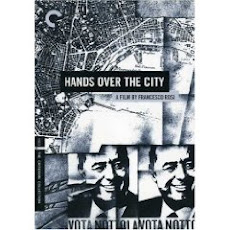A number of you have brought up the ways Emperor's Naked Army questions hegemonic documentary practice: its continuum between documentary social actor and fictional character; its direct acknowledgment of the camera; its thematic interrogation of ethics; its own ethical problematic in facilitating violence; and its use of the performative persona of Okuzaki as a key author-agent of the film.
These are all important - central to the film, even. But I want to sidestep them a little without sidestepping the representational challenge of the film.
And the film is challenging. The spectator is placed in a position of piecing together events from their recounting. Social conflict plays out as ritualistic confrontation. The historical context is distant to viewers not versed in Japanese politics and removed generationally from World War II. Most of all, like other observational documentaries, ascertaining tone is difficult. Ignatiy remarks, "[Hara] may may be giving the real-life Okuzaki authority, but the filmed Okuzaki is a character in Hara's movie. And the movie's intentions are quite different from Okuzaki's." But what are the movie's intentions? And how do we know what they are?
To begin with, the film's narration does surface at key moments. Seymour Chatman talks of the "implied author" effect in narrative cinema, and at crucial times Emperor's Naked Army, too creates an implied author that lets the spectator weigh the veracity of what the interogated officers say. For instance, the film cuts from a verbal account of a 3 day lag before hearing of the war's end to an intertitle telling that 23 days passed instead.


But such blatant assertions of narrational voice are few. I found myself (perhaps unjustifiably) going back to the interview Girish quoted and to Jeffrey and Kenneth Ruoff's helpful reading. From these I gathered that Okuzaki's confrontation appealed to Hara as a way around the static social relations of the documentarist-social actor relationship that forms the basis of Griersonian documentary. This is more than a formal choice: Hara seems to be critiquing political consensus, most likely from a leftist perspective. Ruoff further argues that Hara seizes on the individual figure of Okuzaki as means of opening up a taboo debate about Japanese moral culpabilit
Thankfully, I dug up Akira Lippet's review of Ruoffs' monograph (Film Quarterly Summer 2000) and found my ideology of liberal consensus reading seconded. Lippit is taking issue too with Ruoff's political reading:
Okuzaki's ultra-rightist critique of the Emperor paralyzed Japan's facile politics of the right and left. To state that "after the war, Japanese people preferred to identify with the civilian victims of the A-bombs, rather than with their own soldiers who committed atrocities all across Asia," is not only illogical, but participates in a false dialectic that sees Japan's failure to acknowledge and accept responsibility for its extensive crimes in direct contrast to the American use of atomic weapons in Japan. It is a polemic that appears nowhere in Hara's film, which remains unrelentingly focused on Okuzaki's pursuit of a justice that is both extreme and private.
I, too, had problems with the Ruoff reading: Okuzaki's crusade seemed to challenge militarism in highly militaristic terms of honor and responsibility. But the broader point here is that Emperor's Naked Army seems to stage a confrontation and a revelation of truth without the redemption of dialogue, contemplation, deliberation, or action. Formally and ethically, many documentaries eschew the forms of Griersonian documentary, but this one dismantles the core principles of public sphere address. Documentaries - even personal experimental documentaries or Michael Moore's ironic agitprop - often ask their spectator to know something for future action or even ask her to act now in some capacity as citizen. Emperor's Naked Army mocks this quest for knowledge while enticing it, poses any deliberative action as quixotic while taunting those who are inactive, and sides with confrontation over reason. How many times does a cornered social actor fall back on a defence of "that's my opinion" while the framing registers his deer-in-headlights expression?
Intellectually, it's great to have this problem posed for us to reflect upon. Normatively, though, I don't think this Post-Griersonian worldview lines up simply on the side of the angels.










